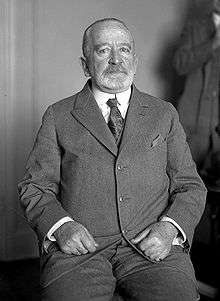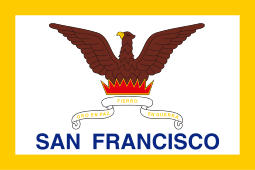James D. Phelan
| James D. Phelan | |
|---|---|
 | |
| United States Senator from California | |
|
In office March 4, 1915 – March 4, 1921 | |
| Preceded by | George Clement Perkins |
| Succeeded by | Samuel M. Shortridge |
| 25th Mayor of San Francisco | |
|
In office January 4, 1897 – January 7, 1902 | |
| Preceded by | Adolph Sutro |
| Succeeded by | Eugene Schmitz |
| Personal details | |
| Born |
April 20, 1861 San Francisco, California |
| Died |
August 7, 1930 (aged 69) Saratoga, California |
| Political party | Democratic |
| Alma mater |
St. Ignatius University University of California-Berkeley |
| Religion | Roman Catholic |
James Duval Phelan (April 20, 1861 – August 7, 1930) was an American politician, civic leader and banker. He served as Mayor of San Francisco from 1897 to 1902 and represented California in the United States Senate from 1915 to 1921. Phelan was also active in the movement to restrict Japanese immigration to the United States.
Early years
Phelan was born in San Francisco, the son of James Phelan and Alice Kelly. James Phelan, Sr. was an Irish immigrant who became wealthy during the California Gold Rush as a trader, merchant and banker. James D. Phelan graduated from St. Ignatius College in 1881. Phelan had two sisters, Mary Louis Phelan and a Mrs. Frank J. Sullivan.[1]
Career
He studied law at the University of California, Berkeley and then became a banker. He was elected Mayor of San Francisco and served from 1897 until 1902. He pushed for the reform City Charter of 1898 in San Francisco. He served as the first president of the League of California Cities, which was created in 1898.[2] During this time, Phelan established himself as a leader in what fellow anti-Japanese agitator V.S. McClatchy described as the "holy cause" of Japanese exclusion.[3] He remained active in the anti-Japanese movement after leaving office, securing then-presidential candidate Woodrow Wilson's support for restricting Japanese immigration in 1912 and helping to push through California's discriminatory alien land law in 1913.[4]
Water and land rights
In the 1900s, Phelan bought land and water acreage in various places around the San Francisco Bay Area, and he obtained the rights to the water flow of the Tuolumne River in Hetch Hetchy Valley. Ethan A. Hitchcock, Secretary of the Interior under President Theodore Roosevelt, tried to stop Phelan, but Roosevelt decided that the wild area could be used for "the permanent material development of the region."[5] Phelan's plans for the region included publicly funded water and electricity for a geographical entity he called "Greater San Francisco."[5] With his Bohemian Club fellows, Phelan sought to annex land at the perimeter of San Francisco Bay.[5]
Earthquake recovery efforts
During the 1906 San Francisco earthquake Phelan was a member of the Committee of Fifty, called into existence by Mayor Schmitz to manage the crisis. Afterward, when Dr. Edward Thomas Devine, representing the American Red Cross by appointment of President Roosevelt, was responsible for Relief and Red Cross Funds, ex-Mayor Phelan was allowed to assist Devine, thus keeping the money out of the hands of Schmitz and Abe Ruef. Phelan became Chairman of the Board of Directors of the San Francisco Relief and Red Cross Funds when Dr. Devine was relieved of his post in July 1906.
U.S. Senate

As a Democrat, Phelan ran for the U.S. Senate against Republican Joseph R. Knowland and Progressive Francis J. Heney. He was elected to the United States Senate in 1914 and served from March 4, 1915, to March 3, 1921. Although he had toned down his anti-Japanese rhetoric during World War I, when the United States had allied with Japan, in 1919, Phelan once again began to speak out against the "Yellow Peril," delivering a speech in favor of Japanese exclusion before a special session of the state legislature.[4] He was an unsuccessful candidate for reelection in 1920, defeated by Republican Samuel M. Shortridge, coming in second with 40% of the vote. His defeat may have been the result of his racially tinged campaign; one of his reelection campaign posters contained the headline "Keep California White."[4] (This poster is displayed at the Japanese American National Museum). During his time in the Senate, he was chairman of the U.S. Senate Committee on Railroads during the 64th Congress and of the U.S. Senate Committee on Irrigation and Reclamation of Arid Lands during the 65th Congress.
Later life

After his time in the Senate, Phelan returned to banking and collected art. He remained active in the anti-Japanese movement, collaborating with McClatchy and the Japanese Exclusion League of California to successfully ban Japanese immigrants from entering the country with the Immigration Act of 1924.[4] He died at his country estate Villa Montalvo in Saratoga, California in 1930. He is buried in the family mausoleum in Holy Cross Cemetery in Colma, San Mateo County, California.
Legacy
- After Phelan's death, the Villa Montalvo estate was given to the people of Santa Clara County. It is now a center for the performing and visual arts. Some of his mementos and correspondence are on display in the library at Villa Montalvo.
- Phelan Building in San Francisco, built in 1908.
- Phelan Avenue in San Francisco is named for him.
- The small town of Phelan in the Californian High Desert of the Mojave Desert is named after him.
- James D. Phelan Elementary School in the Moreland School District in San Jose, California, was named for him.
- The James D. Phelan awards, given to young California writers and artists, were established by a bequest in his will.[6]
See also
- John P. Irish, who opposed Phelan over the latter's anti-Japanese proposals
References
- ↑ "Phelan Distinguished Son of City; Mayor of San Francisco Three Terms." San Francisco Chronicle, August 8, 1930.
- ↑ "League of California Cities - Mission & History".
- ↑ Daniels, Roger. The Politics of Prejudice: The Anti-Japanese Movement in California and the Struggle for Japanese Exclusion (Berkeley: University of California Press, 1977), p 91.
- 1 2 3 4 Niiya, Brian. "James D. Phelan". Densho Encyclopedia. Retrieved 13 October 2014.
- 1 2 3 Brechin, Gray. WRCA News, October 2000, Volume 7, Number 3. Populist Rhetoric, Private Gain. Retrieved on July 2, 2009.
- ↑ "Judges announced in Phelan contest". Berkeley Daily Gazette. January 18, 1935. Retrieved 3 October 2012.
- Gordon Thomas & Max Morgan Witts: The San Francisco Earthquake (Stein and Day, New York; Souvenir Press, London, 1971; reprinted Dell, 1972, SBN 440-07631)
External links
| Wikimedia Commons has media related to James D. Phelan. |
- Works by or about James D. Phelan at Internet Archive
- Guide to the James D. Phelan Papers at The Bancroft Library
- James D. Phelan Photograph Albums, 1902-1929 at The Bancroft Library
- Montalvo Arts Center
- United States Congress. "James D. Phelan (id: P000290)". Biographical Directory of the United States Congress.
| Political offices | ||
|---|---|---|
| Preceded by Adolph Sutro |
Mayor of San Francisco 1897–1902 |
Succeeded by Eugene Schmitz |
| United States Senate | ||
| Preceded by George C. Perkins |
U.S. Senator (Class 3) from California 1915–1921 Served alongside: John D. Works, Hiram Johnson |
Succeeded by Samuel M. Shortridge |

